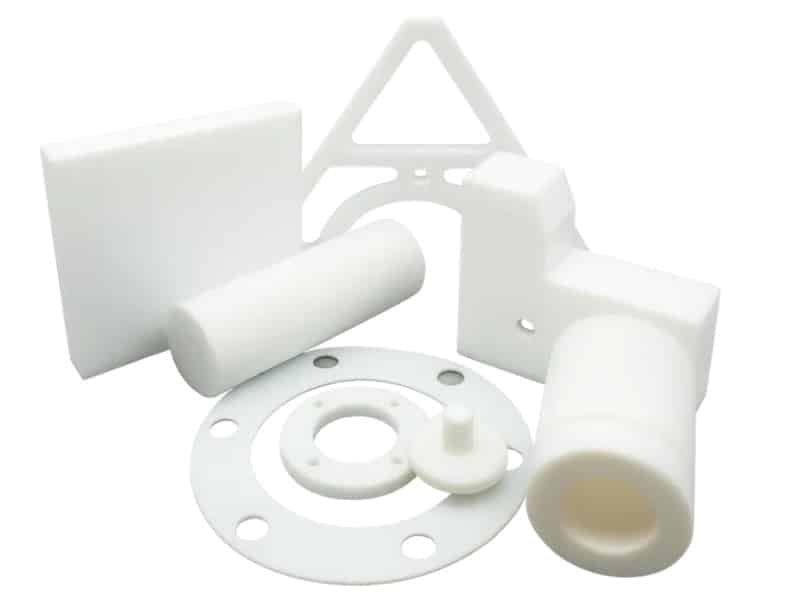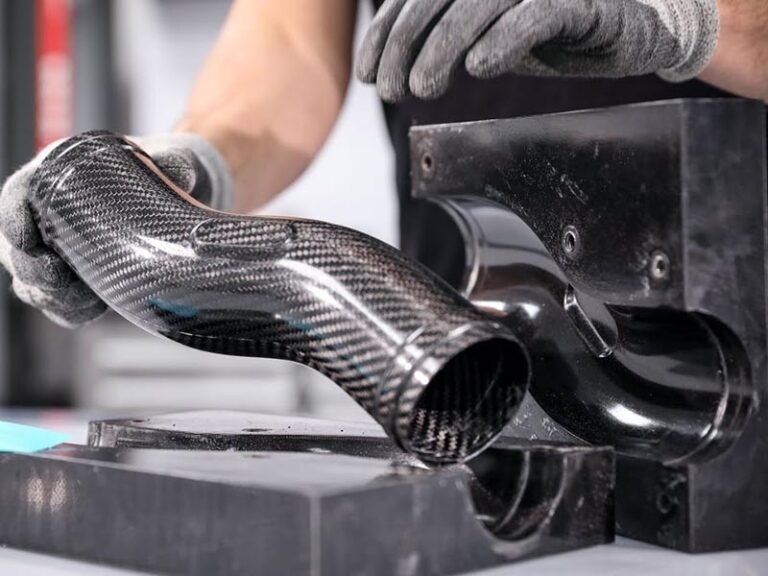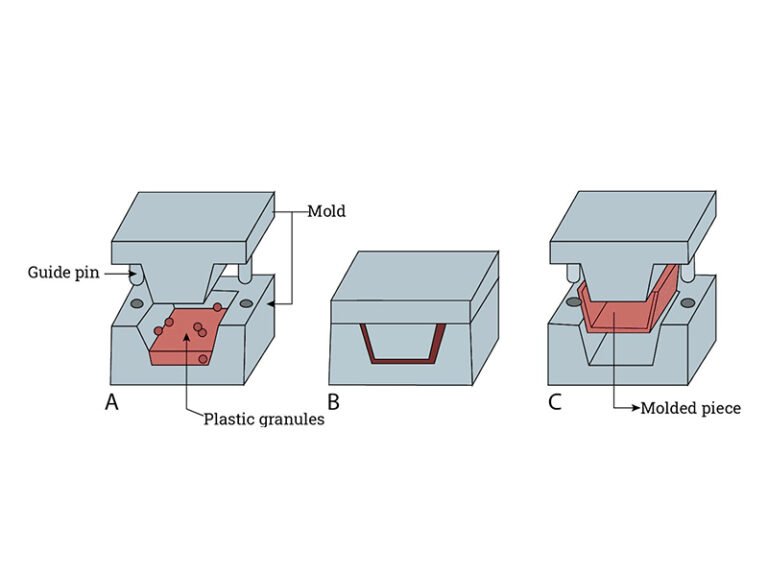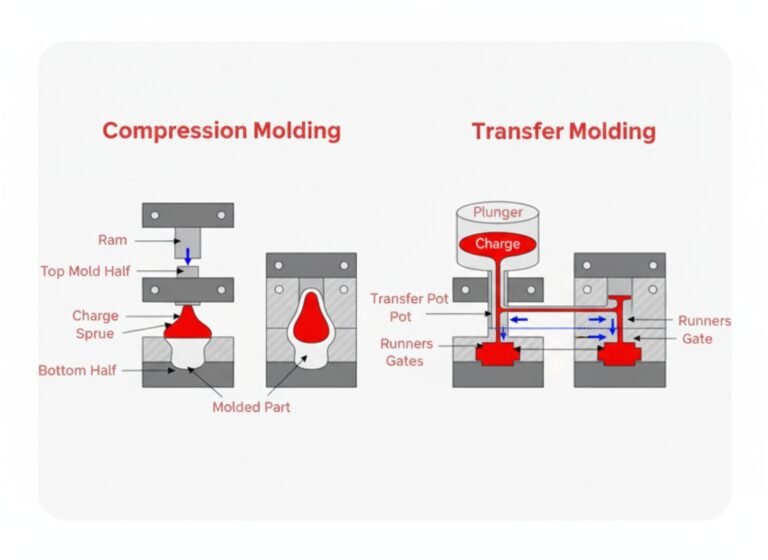Polytetrafluoroethylene (PTFE), commonly known by the brand name Teflon, is a unique engineering thermoplastic. Among the advanced manufacturing methods, PTFE CNC machining is a preferred process for producing precision components. In this guide, we will explore the benefits and limitations of CNC machining PTFE, PTFE machining considerations, and machining skills.
What Is PTFE?
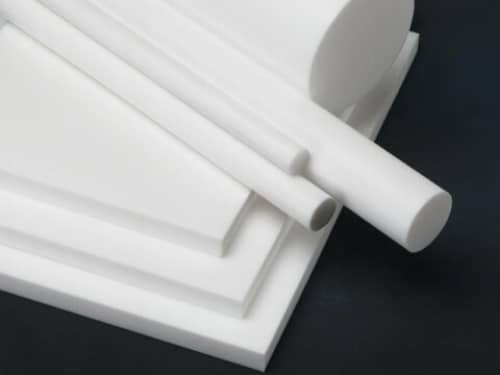
Polytetrafluoroethylene (PTFE), commonly known as Teflon, is a synthetic fluoropolymer characterized by exceptional chemical resistance, low friction, and high thermal stability. PTFE material has a high melting point of approximately 327°C. Its density is about 2.2 g/cm³. It appears as a white, non-toxic, odorless solid with outstanding properties such as excellent electrical insulation, remarkable resistance to nearly all acids and bases, and the ability to operate continuously within a temperature range of approximately -250°C to 260°C. PTFE’s unique molecular structure, with tightly bonded fluorine atoms surrounding carbon chains, grants it superb non-stick surface characteristics and durability against harsh environments.
Common PTFE Grades
PTFE grades vary based on additives that enhance properties for PTFE CNC applications. Common grades include:
- Virgin PTFE: Unfilled, offering maximum chemical resistance for seals and insulators in Teflon PTFE machining.
- Glass-filled PTFE: Contains 15-25% glass fiber, improving wear resistance and reducing creep, used in bearings and gaskets during CNC PTFE processes.
- Carbon-filled PTFE: Adds carbon or graphite for better strength and thermal conductivity, suited for valves in PTFE CNC machining.
- Bronze-filled PTFE: Incorporates bronze powder for enhanced hardness and conductivity, ideal for bushings in Teflon CNC.
- PEEK-filled PTFE: Combines PTFE with PEEK for superior mechanical strength, used in high-load components.
Advantages of CNC Machining PTFE
PTFE CNC machining offers many advantages when it comes to precise, complex machined plastic parts from PTFE:
- High Precision and Repeatability: CNC machines rely on computer numerical control, allowing for extremely accurate cuts and consistent replication of intricate geometric shapes. This significantly reduces human error compared to manual machining.
- Ability to Produce Complex Shapes: Multi-axis CNC machines operate along several axes simultaneously, enabling the production of parts with complex contours and tight tolerances that would be impractical or impossible to produce otherwise.
- Thermal and Chemical Stability of Parts: CNC machining maintains PTFE’s inherent heat resistance and chemical inertness since the milling, drilling, or turning processes remove material rather than alter its composition.
- Minimal Risk of Defects: PTFE CNC machining does not expose the material to high melting temperatures that risk decomposition or volatile emissions, resulting in cleaner, higher-quality parts.
- Rapid Prototyping and Small Batch Production: CNC processes offer quick turnaround times for prototypes and production runs without the time-consuming mold creation required by other manufacturing methods.
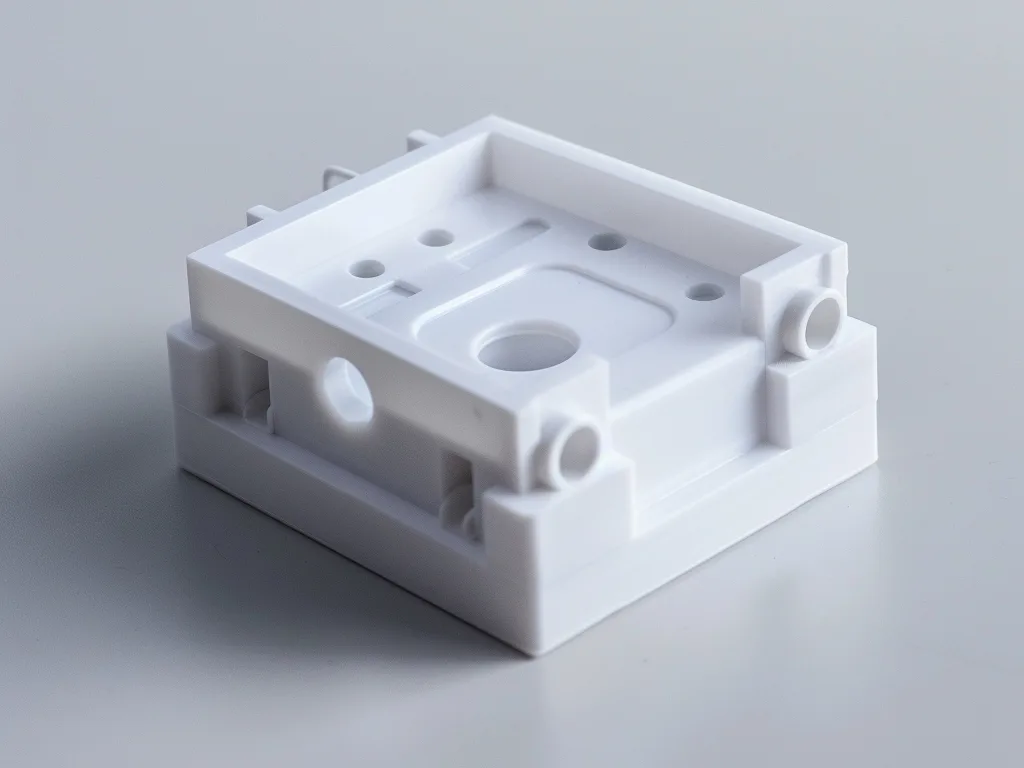
PTFE CNC Machining Service
Limitations of CNC Machining PTFE
Despite these benefits, CNC PTFE machining faces some limitations inherent to the material’s properties:
- Softness and Flexibility: PTFE’s relatively low rigidity can cause chatter during machining, leading to surface imperfections unless tool paths and machine parameters are meticulously controlled.
- Thermal Sensitivity: Although PTFE is heat-resistant, excessive heat generated during machining without sufficient cooling can cause warping or surface deformation.
- Dimensional Instability: PTFE has a high coefficient of thermal expansion and is prone to stress relaxation, making it challenging to maintain the extremely tight tolerances required by some applications.
- Chip Evacuation Challenges: PTFE produces long, stringy chips during machining that must be efficiently removed to prevent tool clogging and maintain cutting precision.
- Cost Considerations: CNC machining tends to be more costly for very high volume runs compared to methods like compression molding or extrusion.
Common CNC Machining Processes for PTFE
Several CNC methods are employed depending on the part geometry and functional requirements:
CNC Milling

Teflon CNC milling involves rotating cutting tools moving along multiple axes to selectively remove material, shaping PTFE blocks into complex parts. Milling produces high-precision surfaces suitable for parts with rough edges or intricate details.
CNC Turning

In CNC turning, a lathe rotates the PTFE workpiece while a cutting tool removes material to create cylindrical or conical shapes. This method is used for producing PTFE components like bushings, bearings, seals, and insulators.
CNC Drilling
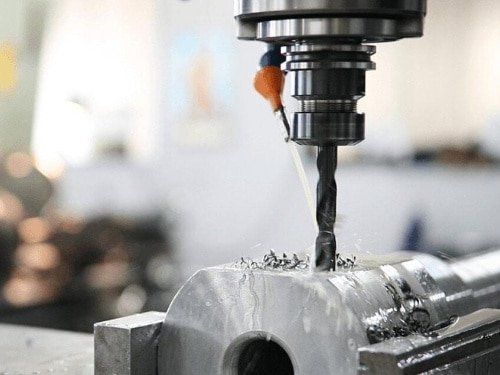
CNC drilling creates holes in PTFE workpieces using rotating drill bits. It is used for PTFE components requiring mounting holes or fluid passages, such as in chemical processing equipment.
CNC Turn-Mill (Mill-Turn) Machining
This advanced hybrid machining combines turning and milling in a single setup, enabling complex PTFE parts, such as hollow parts with a rough bottom surface, to be produced more efficiently without multiple setups.
How to CNC Machine PTFE?
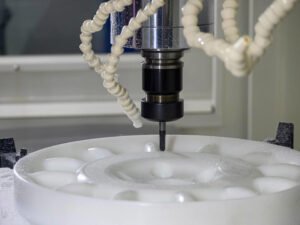
The PTFE CNC machining workflow generally follows these steps:
1. Material Selection and Setup
Select the appropriate PTFE grade based on mechanical, thermal, and chemical requirements. Secure the workpiece using double-sided tape or plastic clamps to prevent movement during machining.
2. Programming and Parameter Configuration
Develop a CNC program defining cutting paths, depths, speeds, and feeds optimized to minimize heat buildup and vibration.
3. Initial Cutting Operations
Begin with rough cuts for large material removal, reducing step-down increments to avoid excessive tool pressure. Monitor chip formation and temperature constantly.
4. Precision Finishing
Perform finer milling to achieve required tolerances and surface finish, adjusting feed rates for smooth cutting without chatter.
5. Drilling or Turning (if applicable)
Use CNC drilling or turning techniques for holes, cylindrical shapes, or hollow features, maintaining perpendicularity and precise tool positioning.
6. Deburring and Cleaning
Remove burrs and sharp edges using PTFE-compatible tools or abrasives to ensure assembly readiness and part longevity.
7. Final Inspection and Quality Control
Verify dimensional accuracy using precise measurement instruments. Check for surface quality and confirm that tolerances and specifications meet standards.
Key Considerations and Machining Tips for PTFE CNC Machining
To optimize teflon PTFE machining quality and efficiency, consider the following:
- Use sharp cutting tools to reduce friction and heat generation, essential for clean surfaces on this non-stick material.
- Implement an effective cooling system (compressed air, water-soluble coolant, or chemically inert sprays) to mitigate thermal expansion and prevent warping.
- Set conservative cutting speeds and step-downs; typical spindle speeds range from moderate RPMs with step increments between 0.3 to 1.5 mm, based on tooling and part complexity.
- Securely mount PTFE sheets with double-sided foam tape supplemented by clamps if needed. Loose material causes vibration and inaccuracies.
- Remove chips frequently to avoid clogging, especially during milling, where long PTFE chips accumulate readily.
- Perform thorough deburring to eliminate sharp edges that can cause assembly issues or early part failure.
- Always consider PTFE’s thermal expansion in tolerance calculations, typically maintaining ±0.001 inch per inch tolerance as a practical guide.
Typical Applications of CNC Machined PTFE Parts
Due to its unique properties and superb machinability via CNC, PTFE parts are widely used across diverse industries:
- Aerospace Industry: Fuel hoses, electrical insulation, sliding bearings, and protective coatings.
- Medical Industry: Biocompatible valves, implants, and tubing.
- Automotive Industry: Lightweight gears, seals, and valve components.
- Food Processing Industry: Conveyor belts, chutes, liners, seals, gaskets, custom fittings.
- Chemical Processing: Corrosion-resistant seals, washers, fittings, and laboratory instrument components.
- Electrical and Electronics: Insulating spacers, housings, cable jackets, connectors, components for high-frequency applications.
Alternatives to PTFE in CNC Machining
Here are some alternatives to PTFE for specific applications:
ECTFE (Ethylene Chlorotrifluoroethylene): ECTFE offers improved chemical and corrosion resistance over PTFE. This material is optimal for harsh chemical environments.
PCTFE (Polychlorotrifluoroethylene): PCTFE is known for extremely low moisture permeability. It can improve sealing effectiveness.
PFA (Perfluoroalkoxy): PFA has similar chemical properties but is softer and less abrasion-resistant than PTFE. However, it is less preferred for structural uses.
Zhongde for Reliable PTFE CNC Machining Services
Zhongde is combining advanced CNC equipment with deep expertise to deliver precision Teflon components. Our capabilities include CNC milling, CNC turning, multi-axis machining, and rigorous quality controls, specifically tailored for PTFE and specialty fluoropolymer materials. Contact Zhongde for PTFE machining requirements or to explore custom CNC service for your next project.
